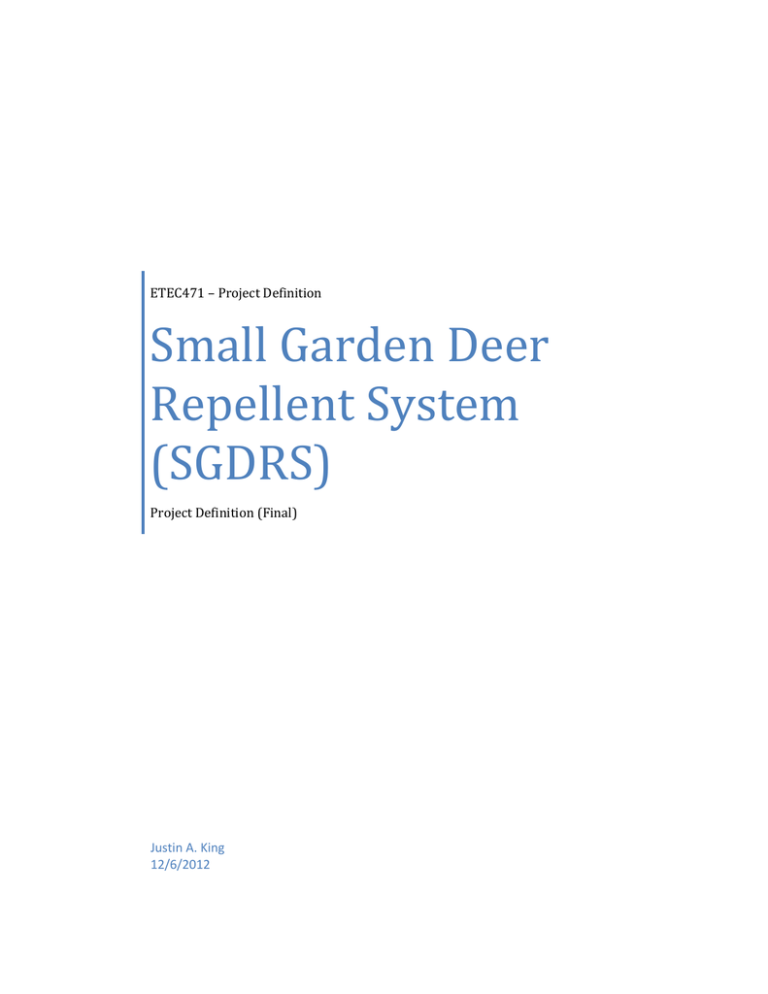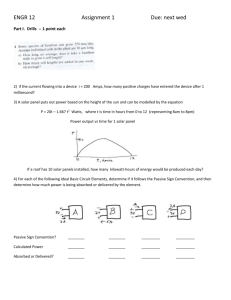ProjectDef_II
advertisement

ETEC471 – Project Definition Small Garden Deer Repellent System (SGDRS) Project Definition (Final) Justin A. King 12/6/2012 Table of Contents Functional Description .................................................................................................................................. 2 Development Plan......................................................................................................................................... 9 Electrical Specifications............................................................................................................................... 11 Preliminary Parts List .................................................................................................................................. 13 1 Functional Description Introduction The SGDRS utilizes an infrared motion detector module to monitor a small area in front of the device (510 ft). When the infrared motion detector goes off, it will send a signal to a microcontroller that will be in sleep mode to conserve power. Once the signal is received, the microcontroller will wake up. To conserve deer repellent spray, the microcontroller will check to see the last time it sprayed the plants. If it has sprayed the plants within the past day, it will not spray again and will return to sleep mode. If it has not sprayed the plants within the past day, it will send a signal to an electronic solenoid module that will press down on an aerosol and spray the plants. After sending the signal to the solenoid module, the microcontroller will record the time as the new “last time sprayed”, and it will return to sleep mode to conserve power. The entire system is designed to run off of battery power, in order to enable the user to plant the SGDRS in any chosen location. Project Hardware – The hardware for this project has changed quite a bit along its development. See Hardware description for details changes. The project hardware consists of several modules that are controlled by, or used to power the Stellaris LM4F120. Microcontroller (pictured in figure 1): This project utilizes the LM4F120H5QR Stellaris Launchpad for all processing requirements. Max size: 60 x 57 x 11mm. Figure 1 2 Source (Figure 2): The SGDRS is powered by a 9V battery (V1), which is put through a voltage regulator circuit using a 5V regulator (LM7805). Max size: 60 x 60 x 30mm. U1 LM7805C Vo = 5V OUT GND IN C1 10u C2 1u V1 9 Figure 2 GND PIR Detector (Pictured in Figure 4): The HC-SR501 PIR detector integrated circuit requires a voltage of 4.5 – 20V. In this project, it will run off of the 9V source and output to an I/O pin on the Stellaris LM4F120. Max size: 32 x 24 x 10mm. Functional diagram: 9V Source Vi = 9V HC-SR501 Figure 3 Module: Figure 4 3 Vo = 3.3V Stellaris LM4F120 Solar Panel (pictured in figure 6) and Capacitor bank: The output solenoid circuit will be driven by a 12V capacitor bank, which is charged with a 12V, 1.5W solar panel (V1) to save battery power. Max size: 155 x 88 x 30mm. Basic circuit diagram: D1 1BH62 C2 50000µF V1 12 V Figure 5 Solar module: Figure 6 4 Solenoid circuit (figure 7): The Solenoid circuit takes the output from a Stellaris pin (V1 = 3.3v) and uses it to drive a MOSFET (T1), which in turns drives the solenoid (CR1). The 12V supply (V2) is a capacitor bank that is charged by a solar panel. Max size: 60 x 40 x 40mm. V2 12 D1 R2 CR1 T1 V1 3.3 R1 Figure 7 Additional hardware: In addition to the electronic hardware, the SGDRS also requires a refillable aerosol spray can to be filled with the selected deer repellent spray. The solenoid in the solenoid circuit (figure 7) will be used to depress the sprayer of the aerosol can. Detailed Description and Functional Block Diagram Stellaris LM4F120H5QR modules used: A/D Timer Internal pull up / down resistors Internal analog comparator Lower power hibernation module Stellaris ICDI Stellaris LM4F120H5QR resources available for use (note: not using 100% of memory space): UART 32-bit ARM cortex (80mHz operation, 100 DMIPS performance) 256KB single cycle Flash memory 32KB single cycle S-RAM Programmable GPIOs PIOSC (16mHz, 1%) 32.768kHz external oscillator for Hibernation Module 5 Major external peripherals: 9V to 5V regulator circuit (pg 3) PIR detector (pg 3) 12V solar panel and capacitor bank (pg 3) Solenoid output circuit (pg 3) External interrupts: External interrupts are triggered by the output of the PIR detector circuit (pg 3) Power supply: Power provided to the LM4F120 by a 9V battery. Maximum current draw is <50mA. Power provided to output solenoid circuit by 12V capacitor bank. Max current draw is <1A. System functional block diagram (figure 8): Figure 8 6 Specific LM4F120H5QR block diagram (figure 9, from datasheet): Figure 9 7 Software requirements Overall architecture (figure 10): Sleep Motion sensor tripped Yes Check “last time sprayed” Sprayed within 24 hours? No Output to solenoid circuit Update last sprayed time Figure 10 Development programs used: Code Composer Studio StellarisWare LMFlash Programmer Putty Stellaris software modules used: Timer module: Uses the system clock to keep track of time. The Stellaris offers 16 and 32 bit timer modules. Hibernate: Allows the Stellaris to pull only enough power to run the hibernate module. Has a dedicated pin for using external interrupts to wake the Stellaris. External interrupt: The PIR sensor will periodically cause external interrupts, which are handled by an ISR. 8 Major algorithms and tasks: Hibernate cycle: The processor will spend the majority of its time in the hibernate state. Input: Checking an I/O pin for the signal from the PIR. Output: Outputting a signal to an I/O pin for the solenoid circuit. OEM software used: StellarisWare LMFlash Programmer Code Composer Studio User interface The SGDRS does not include a typical user interface such as an LED or LCD screen display. It is an automated device that performs its tasks without requiring the user to interact with the software or hardware. Communication protocols USB 2.0 and the UART interface are used to communicate and program the SGDRS. The final prototype will not require communications, and therefore makes use of no communications protocols. Sustainability design issues The SGDRS requires a 9V battery to run. Because of this, the only waste that it creates is drained 9V batteries. If a 9V rechargeable is used, then it will create no waste. The addition of the solar panel and capacitor bank reduces the draw on the 9V supply and allows it to sustain itself for longer periods of time. Development Plan Development schedule Task Final design of Solar circuit Final design of Solenoid circuit Parts ordering PIR testing and interfacing Voltage regulator construction Voltage regulator testing and interfacing Solar circuit construction Solar circuit testing and interfacing Solenoid circuit construction Solenoid circuit testing and interfacing Stellaris I/O programming Stellaris hibernate programming Prototype construction Prototype testing Start Dec 22nd, 2012 Dec 27th, 2012 January 5th, 2013 January 20th, 2013 January 28th, 2013 January 31st, 2013 February 10th, 2013 February 15th, 2013 February 25th, 2013 March 3rd, 2013 March 15th, 2013 March 28th, 2013 April 13th, 2013 April 15th, 2013 9 Finish Dec 23rd, 2012 Dec 28th, 2012 January 5th, 2013 January 27th, 2013 January 30th, 2013 February 7th, 2013 February 13th, 2013 February 22nd, 2013 February 28th, 2013 March 10th, 2013 March 25th, 2013 April 10th, 2013 April 14th, 2013 April 30th, 2013 Case design Case construction Final prototype construction May 2nd, 2013 May 3rd, 2013 May 7th, 2013 May 2nd, 2013 May 5th, 2013 May 15th, 2013 Development hardware / software required Item Oscilloscope DMM Computer Code Composer Studio StellarisWare LMFlashProgrammer Soldering iron Carving equipment Use Diagnostics / testing Diagnostics / testing Design / Analysis Design / Programming Programming Programming Construction Construction Source EET lab EET lab EET lab / Personal netbook EET lab / Personal netbook EET lab / Personal netbook EET lab / Personal netbook EET lab Personal supplies Prototype description Construction methods The prototype will consist of the individual circuits and modules coupled together and contained within a case. The individual circuits and modules will have the components on break out boards and soldered together. The case will house all of the modules, the Stellaris, and the 9V power supply, as well as an aerosol can that has been filled with a testing spray (most likely a scented spray or water with dye). The prototype will contain the entire Stellaris development board, so it will not necessarily be a “standalone” processor, but it will utilize the Stellaris as a standalone module. Props The prototype will be set up in a pot with a plant so it can spray it as it would in its intended environment. A backboard will also be included with the display, which will contain important data about the functionality of the SGDRS, such as main programs, module circuits and functionality, and power calculations. 10 Electrical Specifications Project specifications Voltage regulator module: 1µF Capacitor o 2% tolerance o T = -55 to +85°C 10µF Capacitor o 2% tolerance o T = -55 to +85°C LM7805, Vo = 5V ± 5% o T = 0 to +125°C o IbiasMAX = 8mA o IoMAX = 2.2A PIR sensor module (HC-SR501): Vin = 5V to 20V Iquiescent < 50µA Vo = 3.3V high / 0V low T = -15 to 70°C Solar Capacitor bank: Solar panel: P0 = 1W ± 5% o VoMAX = 15V o Imax = 65mA o T = -40 to +80°C o Waterproof 330µF, 12V Capacitor o 2% tolerance o T = -55 to +85°C Diode o With breakdown voltage (VBR) >= 14V. Solenoid circuit: Resistors (value [TBD]) o 1% tolerance 11 Solenoid o 12V activation o Rcoil = 40Ω o 0.5" diameter x 1" long tubular solenoid with 3/8" diameter threaded bushing for mounting. 1/16" diameter x 1/2" long plunger. MOSFET o Depletion mode o N-Channel o Vth <= 3.3V o Vds >= 15V Diode o With breakdown voltage (VBR) >= 17V. Stellaris: Vin = 5V (USB standard voltage output) GPIO Vo = 3.3V high / 0V low IiMAX = 100mA (USB standard maximum current draw per device) GPIO IoMAX = 8mA T = -40 to +85°C 80MHz clock / data rate Power requirements 9V battery: 500mAh Estimated life = 50hrs if constantly powered (not hibernating) Worst case P = 100mW 12V Capacitor bank Supplies 12V for driving the solenoid Recharged by solar panel 12 Special environmental requirements Based on temperature ranges for individual components and microprocessor, the operating range for the device is -15 to 70°C. It will be used outdoors, so humidity is a concern. To circumvent, the case will be water-tight to repel rain and the majority of humidity effects. Preliminary Parts List [TBD] = To Be Determined Module Steallaris Dev Board PIR sensor 5V Regulator 9V Battery 15V, 15mF cap 10uF Capacitor 1uF Capacitor 15V, 1W Solar Panel Resistors MOSFET Solenoid Diode Part # LM4F120 HC-SR501 LM7805 Any Any Any Any Any Any Any with Vth <= 3.3V SOL-102 (on website) Any with Vbr >= 17V Quantity 1 1 1 1 1-2 1 1 1 2 1 Cost (total) $14.78 $3.41 [TBD] ~$2.00 <$0.50 <$0.10 <$0.10 ~$10.00 <$0.10 <$1.00 Lead Time 7 days 22 days [TBD] 0 days 0 days 0 days 0 days 14 days 0 days 0 days Source TI DHGate [TBD] Amazon Lab Lab Lab Ebay Lab Lab [TBD] Power [TBD] <1mW ~54mW 0W ideal 0W ideal 0W ideal 0W ideal 0W ideal V2 / R [TBD] ID2*RFET 3.6W 1 <$10.00 2 <$0.50 0 days [TBD] Lab Allelectronics.com Case The case design and components are based on the final dimensions and configuration of the prototype modules. The case will be constructed with Styrofoam, epoxy, resin, plexiglass, and spray paint, all of which can be obtained at a local hardware store. The lead time on these pieces is 0 days, but the price will be determined upon final prototype construction. The price for case construction should not exceed $20.00. 13

![Sample_hold[1]](http://s2.studylib.net/store/data/005360237_1-66a09447be9ffd6ace4f3f67c2fef5c7-300x300.png)



